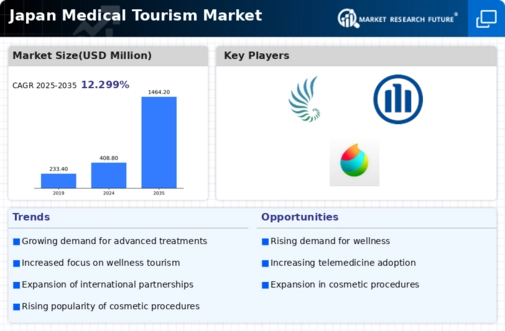The medical tourism market in Japan is characterized by a dynamic competitive landscape, driven by a confluence of factors including advanced healthcare infrastructure, a growing demand for specialized medical services, and an increasing number of international patients seeking high-quality care. Key players such as Bumrungrad International Hospital (TH), Apollo Hospitals (IN), and Cleveland Clinic (US) are strategically positioned to leverage these trends. Bumrungrad International Hospital (TH) focuses on enhancing its service offerings through technological innovations and partnerships with local healthcare providers, thereby strengthening its market presence. Meanwhile, Apollo Hospitals (IN) emphasizes regional expansion and the establishment of new facilities, which appears to be a response to the rising influx of medical tourists. Cleveland Clinic (US) is also investing in digital transformation initiatives, aiming to streamline patient experiences and improve operational efficiencies, which collectively shapes a competitive environment that is increasingly reliant on innovation and patient-centric strategies.
The business tactics employed by these companies reflect a nuanced understanding of the market's structure, which is moderately fragmented yet increasingly competitive. Localizing services and optimizing supply chains are pivotal strategies that enhance operational effectiveness. The collective influence of these key players fosters a competitive atmosphere where differentiation is achieved not solely through pricing but through the quality of care and patient experience.
In October 2025, Bumrungrad International Hospital (TH) announced a partnership with a leading Japanese telemedicine provider to enhance remote consultations for international patients. This strategic move is likely to expand their reach and improve accessibility for patients who may be hesitant to travel. Such initiatives not only cater to the immediate needs of patients but also position the hospital as a forward-thinking entity in the medical tourism sector.
In September 2025, Apollo Hospitals (IN) launched a new facility in Tokyo, aimed at providing specialized cardiac care to international patients. This expansion signifies a strategic commitment to capturing a larger share of the medical tourism market in Japan, particularly in high-demand specialties. The establishment of this facility is expected to bolster Apollo's reputation and operational footprint in the region, potentially attracting patients seeking advanced cardiac treatments.
In August 2025, Cleveland Clinic (US) unveiled a new AI-driven patient management system designed to enhance the patient journey from initial inquiry to post-treatment follow-up. This innovation is indicative of a broader trend towards digitalization in healthcare, which is becoming increasingly vital in attracting and retaining international patients. By integrating AI into their operations, Cleveland Clinic is likely to improve patient satisfaction and operational efficiency, thereby reinforcing its competitive edge.
As of November 2025, the competitive trends in the medical tourism market are increasingly defined by digitalization, sustainability, and the integration of AI technologies. Strategic alliances among key players are shaping the landscape, fostering collaboration that enhances service delivery and patient care. Looking ahead, competitive differentiation is expected to evolve, with a pronounced shift from price-based competition to a focus on innovation, technological advancements, and supply chain reliability. This transition underscores the importance of not only meeting patient needs but also anticipating future demands in a rapidly changing healthcare environment.














Leave a Comment